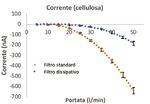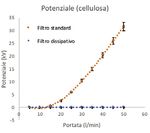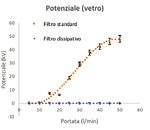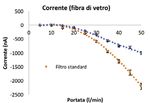ESD in hydraulic filters - COMPONENTS MP Filtri - MP Filtri Spa
←
→
Page content transcription
If your browser does not render page correctly, please read the page content below
COMPONENTS
MP Filtri
ESD in hydraulic filters
The study covered by this article stems from the need to understand and solve
the problem of electrostatic discharges within hydraulic filters, resulting from the
accumulation of electrical charge caused by the passage of oil inside them
by Emanuele Villa and Alessandro Negri
T
here are several problems in environments where flammable Electrostatic theory
of an electrostatic nature materials are present. This paper The accumulation of charge on the
that arise in systems and presents the results of an experimental filters occurs due to triboelectric
industrial environments: study This paper presents the results effects, which take place when two
in machinery and of an experimental study in order to bodies with different electronegativity
on floors, but also in the air and understand the physical phenomena come into contact (or are in friction).
on persons. In the system under that intervene in the observed The term “electronegativity” refers
examination these phenomena can processes and, where possible, to to the intensity of the attraction of a
damage the filter elements, the oils or generate a qualitative comparison nucleus on the surrounding electrons.
other components of the circuits, as between empirical and modelling For composite materials, this will
well as cause fire hazards if you are results. depend on the electronegativity
12 ONSITEUNDERGROUND - september 2021Lower
Glass
Syntetic ester oil
RELATIVE SIGN AS A RESULT
ELECTRONEGATIVITY
Cellulose OF TRIBOLELECTRIC EFFECTS
Mineral oil
Higher
FIG. 1 - Triboelectric scale for material of interest
FIG. 3 = Electrostatic double layer (da STLE annual meeting 2016, W.
Needleman)
FIG. 2 - Triboelectric effect by contact
of their constituent elements. The Fig. 1 shows the
triboelectric scale (which provides information on
the relative electronegativity) for the materials under
examination: cellulose, glass, oils (similar to hydrocarbon FIG. 4 - Formation of net charge accumulation (from STLE Annual
derivatives). In the triboelectric effect, the body with Meeting 2016, W. Needleman)
greater electronegativity snatches electrons from the other,
generating an accumulation of net negative charge on itself, TUBING
charging the other by the same amount, but with opposite
sign. In liquid-solid systems, contact is sufficient to generate OIL
relaxation
this type of effect (Fig. 2). At the microscopic level, a double
layer, is formed, consisting of an accumulation of surface TUBING
charges (Helmholtz layer) on the filter material and a
FIG. 5 - Charge relaxation in the pipes
diffuse layer in the oil volume, whose charge distribution is
exponential (Fig. 3). If the fluid is moving at a certain flow
rate (Fig. 4), the flow carries away the charges in the liquid generating an instantaneous current of very high intensity.
and causes an accumulation of net charge in the system, This is a process that gives rise to an emission of light due
which gives rise to high potentials (up to tens of kV). The to the ionization of the molecules of the passing medium,
dissipation of the charge can occur through conduction or which are sometimes damaged. This process takes place
electrostatic discharge processes. The former are various, in situations where the electric field exceeds the dielectric
but it is useful to focus on the main dissipation mechanism strength (expressed in kV/mm) of the material (this system
in fluids: charge relaxation, represented in Fig. 5. can be assimilated to a capacitor whose plate reaches its
This occurs when the pipes or tanks in which the liquid maximum capacity).
passes or is contained are conductive (and connected to
earth); through convective motions, attracted by the zero Experimental tests
earth potential, the charged particles tend to approach the The experimental apparatus used consists of a test bench
walls, where they release the accumulated charge. In solid containing a hydraulic circuit in which a filter is inserted
insulating components such as plastics, however, only that can retain the solid contaminant and prevent this
conduction currents are generated which, by dissipating from damaging the machinery or the oil itself. The main
the charge, prevent the accumulation of potential from components of a filter are head, filter element and container.
diverging. Rather, the voltage is expected to reach a The filter elements used in this study are composed of a
maximum value when the accumulated charge eaquals filter body, formed by the pleating of one or more layers
that dissipated. The charge accumulated in the system, in (called media), which surround a perforated metal tube
addition to being dissipated by conduction, sometimes gives (spiral tube) and are glued together with two components
rise to discharge phenomena. An electrostatic discharge is called the base and the bead core. In Fig. 6 you can see
the passage of electrons through an insulating medium, the exploded view of a filter. The three aspects presented
the result of which is to bridge the potential difference previously were investigated during the tests: accumulation
between two areas of a body or between two distinct bodies, of electric charge, conduction phenomena, electrostatic
september 2021 - ONSITEUNDERGROUND 13COMPONENTS
1. Head
2. Bead cores
3. Spiral tube
4. Filter body
5. Base
6. Container
FIG. 6 - Exploded view of a filter
discharges. The first occurs in the dielectrics present in are frequent and intense. The discharges occur inside different
the system: filter materials, oil, insulating pipes. As already components of the filter: in the bead core, in the base and
mentioned, the origin lies in the triboelectric phenomena, through the cellulose of the filter layer.
which occur following the passage of the oil through the Significant damage to the filter material has been observed
very fine pores (of the order of ten microns in diameter) of on the cellulose elements, both with the naked eye and using
the insulating filter materials, namely cellulose or fibreglass. an optical microscope (Fig. 7), while the plastic components
show no major damage except in the intersection between
Effects of discharges the spiral tube and the metal head. Therefore, it is assumed
Discharge phenomena are difficult to investigate when they that the discharges occur between the filter body and the
occur, due to the short duration and variability. It is easier to internal support metal tube, from which the electric charge
observe the effects on the bodies crossed: filter and oil. For the then passes to the metal head through a further discharge.
second, it appears difficult to identify and analyse the damaged As for the glass fibre filters, significant damage is observed
molecules, analyses were carried out on the filter elements, only at the level of the bead and of the glue that joins it to
which can be removed from the circuit and analysed in detail the rest of the filter. The burns are visible on the surface and
after use. In particular, it was considered interesting to analyse also extend inside the material (Fig. 8), compromising its
the effects of electrostatic discharges on standard elements mechanical strength. Finding that the fracture line follows
subjected to a 30-minute test at a range at which discharges the lines of damage caused by discharges (discharges that
Voltmeter that measures the filter potential A charge collector integrated into the circuit
14 ONSITEUNDERGROUND - september 2021FIG. 7 – Image of a cellulose septum damaged by the discharge and
microscopic detail of the affected area
FIG. 9 - Images of the epoxy network at various magnifications
of charges in the filters: a sort of electrical circuit must be
created inside the filters themselves, obtained by replacing
some insulating components with similar conductive
versions, so that the charges on the septum are free to move
towards the head and be dissipated to the earth. We will
define the filters thus composed as “dissipative”, as they
FIG. 8 - Detail of the bead core of a glass filter damaged by drains do not avoid the occurrence of triboelectric effects but are
able to dissipate the charge that accumulates, as can be
damage the filter material do not occur, also because the seen from Graphs 1 and 2. The values for the dissipative
glass fibre has a dielectric strength of about 200 kV/mm, elements are represented in blue, those not in red. Note
much higher than those reached in the system). In addition, how, under standard working conditions, the potential goes
minor damage can be seen on the epoxy resin coating of from tens of kV to zero, showing the effectiveness of our
the metal mesh, an element present in the body to hold dissipative filters.
the different layers together (Fig. 9). The hypothesis, in For the glass fibre models the currents (Graph 3) have
this case, is that the charge accumulated on the filtering higher values than those in cellulose, but for both the order
material is collected by the epoxy network, in which a of magnitude is μA. There is an improvement in using the
conduction current passes through the coating of epoxy dissipative elements, despite which, however, no net charge
resin (insulator) which causes damage to it. From the is observed in the oil. The triboelectric effects therefore
network, the charges are then dissipated reaching the metal appear to be minor using dissipative elements, but the oil
head through electrostatic discharges. In fact, discharge charge effect due to the passage in the filter materials is
signs can be observed in the glue that follow the profile of not avoided. The trend of the measured current appears
the network embedded in it. to be, similar to the potential, a rapid but not exponential
growth. However, there is no damping of current growth
Solutions at high flow rates, so that the (asymptotic) saturation trend
A solution has been found to the problem of the accumulation observed for voltage is not repeated. It is believed that this
Potential (glass) Potential (cellulose)
Standard filter Standard filter
Dissipative filter Dissipative filter
Potential (kV)
Potential (kV)
Flow rate (l/min) Flow rate (l/min)
Graph 1 Graph 2
september 2021 - ONSITEUNDERGROUND 15COMPONENTS
Internal view of the R&D Laboratory
of MP Filtri
Current (glass fibre) Current (cellulose)
Current (nA)
Current (nA)
Standard filter Standard filter
Dissipative filter
Flow rate (l/min) Flow rate (l/min)
Graph 3 Graph 4
does not happen since no phenomenon also be a limit for oil if the maximum Conclusions
similar to the electrostatic discharge ionisation of the molecules is reached. The original problem of electrostatic
in the filters takes place in the oil, For such analyses it will be necessary discharges in the filter is avoided by
responsible for limiting the growth in the future to continue the tests on replacing some insulating components
of the potential. However, there may another experimental apparatus. with conductive equivalents. Create
an electric circuit inside the filter
elements, so that the electric charge
ITALIAN ABSTRACT
generated by the triboelectric effects
can dissipate passing through the
ESD NEI FILTRI OLEODINAMICI metal head, connected to earth. The
accumulation of charge in the oil
Lo studio oggetto di quest’articolo nasce dall’esigenza di comprendere e risol- cannot be avoided only by making
vere il problema delle scariche elettrostatiche all’interno di filtri oleodinamici, the filters dissipative; these elements
conseguente all’accumulo della carica elettrica causato dal passaggio dell’olio ensure the dissipation of the charge
al loro interno. La soluzione? Il problema originario delle scariche elettrostatiche that accumulates on the filter, for
nei filtri viene evitato sostituendo alcune componenti isolanti con equivalenti which different countermeasures
conduttivi, che creano un circuito elettrico all’interno degli elementi filtranti, will have to be adopted. The built-in
così che la carica elettrica generata dagli effetti triboelettrici possa dissiparsi charge collector or another dissipater,
passando per la testata metallica, collegata a terra. if inserted in the pipes or in the tank,
could be effective but not decisive. ■
16 ONSITEUNDERGROUND - september 2021You can also read



























































